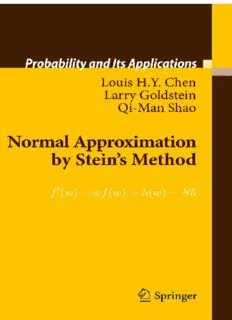
Normal Approximation by Stein’s Method PDF
Preview Normal Approximation by Stein’s Method
Probability and Its Applications PublishedinassociationwiththeAppliedProbabilityTrust Editors:S. Asmussen,J. Gani,P. Jagers,T.G.Kurtz PhotoofCharlesStein,infront,with,fromlefttorightintherear,Qi-ManShao,LouisChenand LarryGoldstein,takenataconferenceatStanfordUniversityheldinhonorofCharlesStein’s90th birthdayonMarch22nd,2010 Forfurthertitlespublishedinthisseries,gotowww.springer.com/series/1560 Louis H.Y. Chen (cid:2) Larry Goldstein (cid:2) Qi-Man Shao Normal Approximation by Stein’s Method LouisH.Y.Chen Qi-ManShao DepartmentofMathematics DepartmentofMathematics NationalUniversityofSingapore HongKongUniversityofScienceand 10LowerKentRidgeRoad Technology Singapore119076 ClearWaterBay,Kowloon RepublicofSingapore HongKong [email protected] China [email protected] LarryGoldstein DepartmentofMathematicsKAP108 UniversityofSouthernCalifornia LosAngeles,CA90089-2532 USA [email protected] SeriesEditors: SørenAsmussen PeterJagers DepartmentofMathematicalSciences MathematicalStatistics AarhusUniversity ChalmersUniversityofTechnology NyMunkegade andUniversityofGothenburg 8000AarhusC 41296Göteborg Denmark Sweden [email protected] [email protected] JoeGani ThomasG.Kurtz CentreforMathematicsanditsApplications DepartmentofMathematics MathematicalSciencesInstitute UniversityofWisconsin-Madison AustralianNationalUniversity 480LincolnDrive Canberra,ACT0200 Madison,WI53706-1388 Australia USA [email protected] [email protected] ISSN1431-7028 ISBN978-3-642-15006-7 e-ISBN978-3-642-15007-4 DOI10.1007/978-3-642-15007-4 SpringerHeidelbergDordrechtLondonNewYork LibraryofCongressControlNumber:2010938379 MathematicsSubjectClassification(2010):60F05,60B12,62E17 ©Springer-VerlagBerlinHeidelberg2011 Thisworkissubjecttocopyright.Allrightsarereserved,whetherthewholeorpartofthematerialis concerned,specificallytherightsoftranslation,reprinting,reuseofillustrations,recitation,broadcasting, reproductiononmicrofilmorinanyotherway,andstorageindatabanks.Duplicationofthispublication orpartsthereofispermittedonlyundertheprovisionsoftheGermanCopyrightLawofSeptember9, 1965,initscurrentversion,andpermissionforusemustalwaysbeobtainedfromSpringer.Violations areliabletoprosecutionundertheGermanCopyrightLaw. Theuseofgeneraldescriptivenames,registerednames,trademarks,etc.inthispublicationdoesnot imply,evenintheabsenceofaspecificstatement,thatsuchnamesareexemptfromtherelevantprotective lawsandregulationsandthereforefreeforgeneraluse. Coverdesign:VTEX,Vilnius Printedonacid-freepaper SpringerispartofSpringerScience+BusinessMedia(www.springer.com) This bookisdedicatedtoCharles Stein. We alsodedicatethisbooktoourfamilies. Annabelle,Yitian,Yipei Nancy JienaandWenqi Preface Stein’s method has developed considerably since its first appearance in 1972, and presentlyshowseverysignthatitsrangeintheoryandapplicationswillcontinueto expand.Nevertheless,theremustbesomepointalongthiscontinuingpathwhenthe methodreachesacertainlevelofmaturitythatathorough,selfcontainedtreatment, highlightedwithasamplingofitsmanysuccesses,iswarranted.Theauthorsofthis bookbelievethatnowisthistime. IntheyearssinceStein’smethodforthenormalwasintroduced,therecognition ofitspowerhasonlyslowlybeguntopercolatethroughouttheprobabilitycommu- nity,helpedalong,nodoubt,bythemainreferencesinthefieldoverthelastmany years,first,themonographofStein(1986),thecompilationofDiaconisandHolmes (2004),andtheseriesofBarbourandChen(2005a,2005b).Nevertheless,touseone barometer,todatethereexistonlyasmallnumberofbooksormonographs,targeted generallyandaccessibleatthegraduateorundergraduatelevel,thatmakeanymen- tionofStein’smethodforthenormalatall,inparticular,thetextsofStroock(2000) andRossandPeköz(2007).Withathoroughbuildingupofthefundamentalsnec- essarytocoverthemanyformsthatStein’smethodforthenormalcantaketodate, andtheinclusionofalargenumberofrecentdevelopmentsinboththeoryandap- plications,wehopethisbookonnormalapproximationwillcontinuetoaccelerate the appreciation, understanding, and use of Stein’s method. Indeed, as interest in the method has steadily grown, this book was partly written to add to the list we cangiveinresponsetothemanyquerieswehavereceivedovertheyears,regarding sourceswhereonecangotolearnmoreaboutthemethod,and,moreover,togeta senseofwhetheritcanbeappliedtonewsituations. Wehavemanytothankforthisbook’sexistence.Thefirstauthorwouldliketo thankCharlesSteinforhisideaswhichtheformerlearnedfromhimasastudentand whichhasbeenarichsourceofinspirationtohimovertheyears.Hewouldalsolike to thank his co-authors, Andrew Barbour, Kwok-Pui Choi, Xiao Fang, Yu-Kiang Leong, Qi-Man Shao and Aihua Xia, from whom he has benefited substantially throughmanystimulatingdiscussions. ThesecondauthorfirstheardaboutStein’smethod,forthePoissoncase,inalec- turebyPersiDiaconis,andhethankshisfirstteachersinthatarea,RichardArratia andLouisGordon,forconveyingarealsenseoftheuseoftheSteinequation,and vii viii Preface MichaelWatermanforprovidingafountainofwonderfulapplications.Helearned themostaboutthenormalapproximationversionofthemethod,andaboutitsap- plications,fromhisworkwithYosiRinott,towhomheismostgrateful.Hehasalso benefitedgreatlythroughall his othercollaborationswhereStein’smethodplayed arole,mostnotablythosewithGesineReinert,aswellaswithAihuaXia,Mathew Penrose,andHaimengZhang. ThethirdauthorwouldliketothankLouisChenforintroducinghimtoStein’s method,andfortheinspirationandinsighthehasprovided. AlltheauthorswouldliketothanktheInstituteforMathematicalSciences,atthe National University of Singapore, for their support of the many Singapore confer- ences,whichservedasanexusforthedisseminationofthemostrecentdiscoveries bytheparticipants,andfor thecreationof a perfectenvironmentfor theinvention ofnewideas. Forcommentsandsuggestionsregardingthepreparationofthisworktheauthors wouldparticularlyliketothankJasonFulman,IvanNourdinandGiovanniPeccati for their guidance on the material in Chap. 14. Additionally, we thank Subhankar Ghosh and Wenxin Zhou for their help in various stages of the preparation of this book,andproofreading,andXiaoFangforhisassistanceandhelpinwritingparts of Chap. 7, on Discretized Normal Approximation. The first author was partially supported by the Tan Chin Tuan Centennial Professorship Grant C-389-000-010- 101 at the National University of Singapore during the time this manuscript was prepared,thesecondauthoracknowledgesthegrantsupportofNSA-AMS091026, andthethirdauthoracknowledgesgrantsupportfromHongKongResearchGrants Council(CERG-602608and603710). For updates and further information on this book, please visit: http://mizar.usc. edu/~larry/nabsm.html. Contents 1 Introduction . . . . . . . . . . . . . . . . . . . . . . . . . . . . . . . . 1 1.1 TheCentralLimitTheorem . . . . . . . . . . . . . . . . . . . . . 1 1.2 ABriefHistoryofStein’sMethod . . . . . . . . . . . . . . . . . . 3 1.3 TheBasicIdeaofStein’sMethod . . . . . . . . . . . . . . . . . . 4 1.4 OutlineandSummary . . . . . . . . . . . . . . . . . . . . . . . . 8 2 FundamentalsofStein’sMethod . . . . . . . . . . . . . . . . . . . . 13 2.1 Stein’sEquation . . . . . . . . . . . . . . . . . . . . . . . . . . . 13 2.2 PropertiesoftheSolutions . . . . . . . . . . . . . . . . . . . . . . 15 2.3 ConstructionofSteinIdentities . . . . . . . . . . . . . . . . . . . 18 2.3.1 SumsofIndependentRandomVariables . . . . . . . . . . 19 2.3.2 ExchangeablePairs . . . . . . . . . . . . . . . . . . . . . 21 2.3.3 ZeroBias. . . . . . . . . . . . . . . . . . . . . . . . . . . 26 2.3.4 SizeBias . . . . . . . . . . . . . . . . . . . . . . . . . . . 31 2.4 A General Framework for Stein Identities and Normal ApproximationforLipschitzFunctions . . . . . . . . . . . . . . . 36 Appendix . . . . . . . . . . . . . . . . . . . . . . . . . . . . . . . . . . 37 3 Berry–EsseenBoundsforIndependentRandomVariables . . . . . . 45 3.1 NormalApproximationwithLipschitzFunctions . . . . . . . . . . 46 3.2 TheLindebergCentralLimitTheorem . . . . . . . . . . . . . . . 48 3.3 Berry–EsseenInequality:TheBoundedCase . . . . . . . . . . . . 49 3.4 TheBerry–EsseenInequalityforUnboundedVariables. . . . . . . 53 3.4.1 TheConcentrationInequalityApproach . . . . . . . . . . 53 3.4.2 AnInductiveApproach . . . . . . . . . . . . . . . . . . . 57 3.5 ALowerBerry–EsseenBound . . . . . . . . . . . . . . . . . . . 59 4 L1 Bounds . . . . . . . . . . . . . . . . . . . . . . . . . . . . . . . . . 63 4.1 SumsofIndependentVariables . . . . . . . . . . . . . . . . . . . 65 4.1.1 L1 Berry–EsseenBounds . . . . . . . . . . . . . . . . . . 65 4.1.2 ContractionPrinciple . . . . . . . . . . . . . . . . . . . . 69 ix
Description: